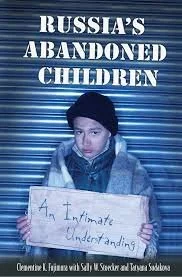American Dad (and Mom)
For Western adoptive parents, adoptable children are embodied entirely in terms of suffering and need. The vast literature on transnational adoption in general (as opposed to research focusing on Russia) speaks of the construction of the "waiting" child, who languishes in sub-Dicknesian orphanages in the vain hopes of being given a loving home. These children are, indeed, waiting, but, technically, many of them are waiting for their mothers who have not relinquished parental rights to come back to them. But even setting aside this hugely important point, the construction of the "waiting" child depends on a discourse of mutual presence and mutual lack. Lack, in that the children desperately need basic care and warmth, but also in that many of the adoptive parents themselves suffer from the unfulfilled need for a child to take care of. Presence, in that the child him or herself embodies the thing so wanted by the would-be mother or father. Orphans and infertility make a perfect closed loop of pathos.
More puzzling to the Russian media are the parents motivated not by childlessness but by sheer altruism, often (but by no means exclusively) in the form of an evangelical Christian calling. Altruism and childlessness part ways when it comes to motivation, but share a common sense of the "waiting" child. The marketing aspects of both the industry of international adoption and the smaller industry of the adoption memoir trade on the orphan as poster child: while would-be adoptees may be shown in the most flattering and attractive light to would-be parents, the deployment of images of such children as part of a political or cultural campaign is rather different. In such cases, the child simply can never be abject enough. Witness the cover of Russia's Abandoned Children: the dirtiness of this child seems awfully mannered, the dirt here equivalent to make-up applied before a photo shoot.
Please, sir, could I have some more…subtle book covers?
Simultaneously the objects of pity and the subjects of suffering, these children are both intensely national (Russian orphans are not Chinese orphans--their living conditions and bureaucratic fates are the products of their local circumstances) and essentially fungible (Russian orphans are not Chinese orphans--most of them can be read as white and seamlessly incorporated into mainstream white America). American attitudes towards transnational adoptees have evolved significantly since the 1950s: adoptive parents of Asian babies are now more likely to try to connect the children to their natal cultures, and part of the motivation has to be a recognition that the children will always be visibly distinct from their (usually white) adoptive parents. But even here, the assumption is that an adoptive child's needs are primarily emotional, material, pedagogical, and medical. Regardless of national origin, a child is a child is a child, to be assessed and evaluated as an individual subject that must be saved and provided a better life, rather than part of a national body whose integrity must be preserved at all cost.
It is easy to look at the relationship between Russian orphans and Western (particularly American) would-be parents as one of supply and demand; indeed, the very appropriateness of this formulation highlights one of the primary sources of unease about such adoptions in Russia: that children are being moved across borders as part of market transactions. This concern is by no means unique to Russia, nor can it be dismissed: the highly publicized cases of child theft and sale in numerous countries, most notably Guatemala, confirm that this is an enterprise that almost effortlessly lends itself to corruption and exploitation (E.J. Graff has an especially damning expose called "The Lie We Love" in Foreign Policy) . But the timing of transnational adoption from Russia and the former Soviet republics had to heighten such concerns. As the countries' borders were opened and trade restrictions virtually abolished, Russia was awash in cheap imports, both physical (Snickers) and cultural (Santa Barbara); in return, Russia exported precious, non-renewable natural resources (minerals and oil). As I have argued elsewhere (and repeatedly), anxieties about rapacious capitalism and a country for sale took on symbolic form in the media and culture industries through the focus on Russian women (as mail-order brides and prostitutes) and urban legends about kidnapping, trafficking, and murder for the sake of organ harvesting. These symbols combine a dehumanizing commodification with a sense of national dismemberment, and they were quickly joined by the figure of the Russian child adopted by foreign parents.
Next: Children for Export
